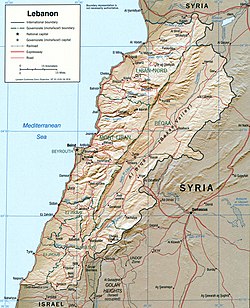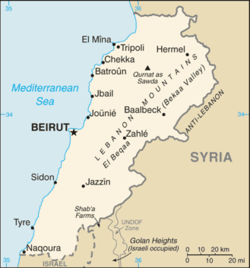

The following outline is provided as an overview of and topical guide to Lebanon:
Contents
- General reference
- Geography of Lebanon
- Environment of Lebanon
- Regions of Lebanon
- Demography of Lebanon
- Neighbors of Lebanon
- Government and politics of Lebanon
- Branches of the government of Lebanon
- Foreign relations of Lebanon
- Law and order in Lebanon
- Military of Lebanon
- Local government in Lebanon
- History of Lebanon
- Culture of Lebanon
- Art in Lebanon
- Sports in Lebanon
- Economy and infrastructure of Lebanon
- Education in Lebanon
- See also
- References
- External links
Lebanon – sovereign country located along the eastern edge of the Mediterranean Sea in Southwest Asia and the Middle East. [1] Lebanon, due to its tense sectarian diversity, has a unique political system, known as confessionalism, in which each religious group is allocated a fixed number of seats in parliament. [2] The country enjoyed a period of relative calm and prosperity before the devastating Lebanese Civil War from 1975 to 1990. [3] In 2005, a wave of demonstrations known as the Cedar Revolution ended the 30-year Syrian occupation of Lebanon. By early 2006, a considerable degree of stability had been achieved throughout much of the country and Beirut's reconstruction was almost complete, [4] but a debilitating 2006 war and internal strife caused significant economic damage and loss of life. Since 2019, Lebanon has faced a serious financial and economic crisis as well as political instability and social unrest, exacerbated by the 2020 Beirut explosion. [5] [6]





